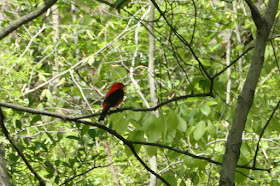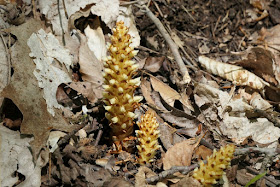On the evening of May 21st or early morning of May 22nd two owlets fledged from their nest, located within a sycamore in the back yard between our house and the neighbors. (Owls are cavity nesters.) Joan spotted them and had to restrain herself from interrupting me on the bicycle rollers. As soon as I stopped, it was time to grab the camera and head outside.
The parent was observing from a small distance, less than the width of our yard from the youngsters.
One fledgling was larger than the other, but had chosen a slender tree and was barely 15 feet above the ground.
Its smaller sibling had managed to climb a much larger ash tree, and was resting at least 3x higher.
A nice shot of it looking up.
Early the next morning Joan was excited to see the two parents engaged in grooming each other. By the time I got my camera they had taken a step apart, as if to say, "Nothing happening here."
With each successive morning the fledglings were higher/deeper in the woods. On the 25th we spotted a parent taking food to the large chick; we couldn't identify the prey item because the exchange was taking place on the far side of the tree.
It's been three years since we observed very young owlets, and even earlier one time the nest was predated in the middle of the night. What a howl we heard then! It makes this year's success all the more exciting.

































































